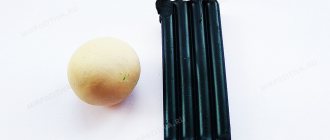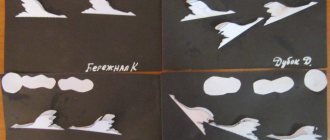Pencil drawings step by step of a bird in flight
Drawing birds is a fun activity. Not every person knows how to draw a bird. Many people think it is difficult. In fact, drawing a drawing of a bird in flight with a pencil is not difficult for beginners or even children if you do it step by step with the help of samples and templates. It's easier to draw the outline of the bird first, and then draw the birds' feathers along the surrounding outline.
Drawing a bird is a task that often confronts children and their parents, which is why it is very popular. Using visual lessons and acting step by step, step by step, you can make a high-quality and clear drawing. After several practices of drawing a bird, you will get better and better.
Next, we suggest looking at pencil drawings to sketch a bird in flight.
Source: https://BipBap.ru/kartinki-dlya-srisovki/risunki-karandashom-poetapno-ptitsa-v-polete-28-foto.html
Summary of the art lesson “Spring has come, the birds have arrived”
Lyudmila Nesterova
Abstract of an art lesson “Spring has come, the birds have flown”
1. To promote the development in children of observation and aesthetic perception of the world around them.
2. To arouse the desire in children to convey on paper the characteristic features of spring (high blue sky, the ground is cleared of snow, buds are swelling on the trees, birds are flying in ), harmoniously arrange the plot on a sheet of paper, develop a sense of composition.
Slides with images of natural phenomena characteristic of spring. Slides with images of various primrose flowers.
Sheets of white thick paper, multi-colored lime crayons, watercolors, brushes, jars of water, napkins, oilcloths.
Memorizing poems about spring , reading works of natural history, observing while walking (thawed patches, puddles and streams, snow-white cumulus clouds, migratory birds , asking riddles about spring .
Summary of an open lesson on fine art in the preparatory group “Birds in Spring”
Summary of an open lesson on fine arts in the preparatory group
"Birds in Spring"
Goals and objectives:
- Foster a love of nature.
— Develop the creative abilities and cognitive interests of preschoolers.
— introduce paintings by Russian artists about spring
-Develop imagination, thinking, coherent speech, observation;
— To consolidate children’s knowledge about spring phenomena in nature, the ability to notice changes in nature and convey them using drawings.
-Develop the skill, the ability to depict a bird and its nest, based on generalized ideas about birds. Learning to use a variety of techniques for working with graphic materials (end, flat, shading) in the process of performing a plot drawing.
— Cultivate accuracy when performing drawings.
Preliminary work.
Reading V. Bianchi’s “Sinichka calendar” March, April; V. Snegirev “Starling”. Learning poems, proverbs, sayings on the topic.
Acquaintance with the work of the artist A. Savrasov. Examination of reproductions of paintings, books, postcards, illustrations depicting birds and their nests.
Equipment:
Presentation with reproductions of paintings, audio recording of the work by F. Chopin - “Spring Waltz”, phonogram with a recording of the voices of birds in the spring forest; Sanguine and charcoal chalk.
Progress of the lesson
The teacher gathers the children around him.
Q - Guys, guests came to our lesson today, let’s say hello to them. Children greet guests.
I have prepared a surprise for you, sit on the carpet, close your eyes and listen
Ready?
I turn on a video with bird sounds
Q. What did you hear?
D. Birds singing
Q. When can you hear such birds singing?
D: This happens in the spring.
Educator:
Our land is beautiful in all seasons. But there is a time in nature when everything seems to wake up and live in anticipation of warmth and sun.
Spring gives everyone the joy of new life and the expectation of a miracle. Joy inspires, makes you act and create. This feeling covers all people: poets write poems, composers compose music, and artists paint pictures.
V.: And I want to invite you to an art gallery and show you paintings by great artists about this wonderful time of year.
Show presentation
IN:
Composers write music using notes, words and rhymes help the poet, and artists express their emotions using what?
D:
.. artists paint not only with paints. Look, what do you think is used in this picture? And it was written in sanguine.
Progress of the lesson:
The teacher asks the children a riddle:
When does this happen?
in spring!
That's right, as you already guessed, today we will talk about spring . People have long loved spring . People called her " spring-red "
.
Poets wrote poems about . Which of you can remember and read us poems about spring ?
(Children read poems that they had previously learned in the group of I. Pleshcheev, S. Marshak).
Look, guys, what kind of spring guests came to our kindergarten (puts three dolls on the table, decorated with: snowdrops - Vesna Martovna Podsnezhnikova, birds - Vesna Aprelevna Skvoreshnikova, cherry berries - Vesna Mayevna Chereshnikova and introduces them).
Our guests have the same first names, but different middle and last names. Why do you think they are called that? (The first name is the name of the season, the patronymic is the name of the spring month, and the last name is the name of one of the signs of this month).
In what month do snowdrops begin to bloom?
When do starlings arrive ?
Now try to remember - when will the cherry tree ripe?
Let's now take a closer look at the spring guests - Vesna Martovna Podsnezhnikova, Vesna Aprelevna Skvoreshnikova and Vesna Mayevna Chereshnikova! Have you met? That's good.
Guys, please remember what the very first month of spring is called? (Children's answers)
.
How will we know that spring has come ?
Who can name the signs of spring? The sun is high, shining brighter, the day is getting longer, drops are ringing, the snow is turning black and melting.
If all the snow melts, what will we see?
What will it be like after winter, freed from under the snow?
Black, wet. (Slide shown)
.
What do the trees look like? What can you notice?
Buds swell on tree branches, the first spring flowers appear, and the first grass emerges.
(Next slide shown)
.
What kind of first spring flowers do you children know?
Snowdrops, coltsfoot, dream grass.
(Slides with various primrose flowers are shown)
.
What birds come to us in the spring ?
Rooks, starlings, swallows, larks.
Let's draw pictures on the theme “ Spring has come . The birds have arrived "
.
We will draw with wax crayons, and at the end we will use watercolors to create the background of the drawing - this is a blue sky, and below is green grass. First, think about the plot of the drawing. What can you depict? (Trees, thawed patches and puddles on the ground, sun, birds , nests, etc.).
But before we get to work, let's prepare our fingers and do finger exercises. (Musical finger gymnastics by L. Yartov “Fingers”
).
Now let's get to work, and the music will help you feel how nature wakes up after the winter cold. Listen to how the music conveys the spring mood and try to reflect it on paper.
The children begin to work, the teacher monitors the children’s posture so that they can hold the hand correctly and freely, without tension.
At the end of the lesson , the works are exhibited at the exhibition, the children exchange impressions - which drawing they liked and why. The teacher celebrates successful work and encourages all children.
Guys, today we talked a lot about spring , looked at slides with illustrations. Each of you tried, and in your drawings it is clear that nature has awakened and come to life. And now let's say goodbye to our guests - Spring Martovna Podsnezhnikova, Spring Aprelevna Skvoreshnikova, Spring Mayevna Chereshnikova. Goodbye!
Summary of the final lesson on speech development in the middle group “Spring has come” Summary of the final lesson on speech development in the middle group “Spring has come” Zakharova V.V., teacher. Sevastopol, State Budgetary Educational Institution “Educational.





